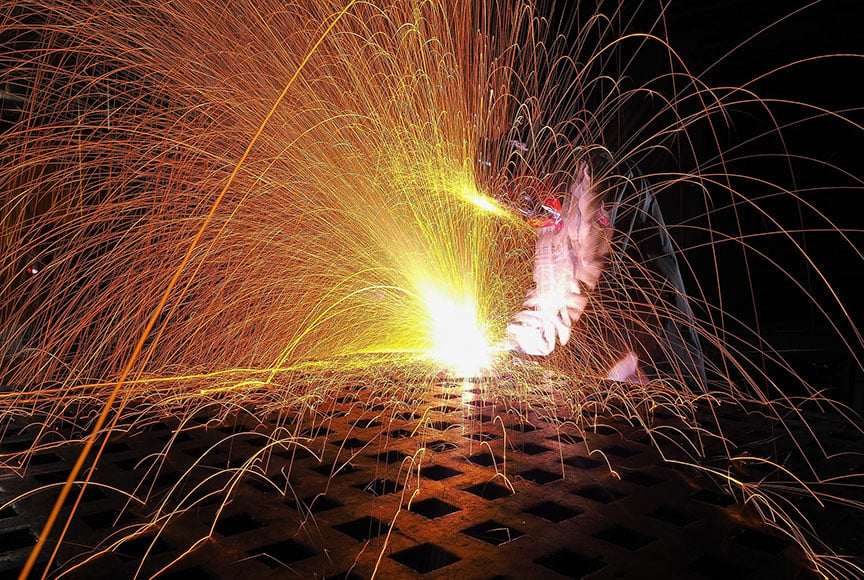Every fabrication shop knows that a safe shop is a productive shop. Metalworking comes with a wide variety of risks many of which involve the relationship between the tools, the space, and the operator. This network of place, people, and things can seem overwhelming to refine, but with the right plan and goals in mind, your shop will prosper saving time, energy, and money.

Check with Regulators
Think big at the start. OSHA is not just the regulator and enforcer of proper shop safety standards, but a resource to help discover better, safer methods of operating your business. A shop manager or leader can use this simple checklist to self-assess the shop and this checklist for abrasives at the start of each workweek. This step will save you hours of fixing tools, rearranging, and inevitable mishaps.
From the proper way to secure and transport gas cylinders across the shop floor to requiring torches to be inspected at the beginning of each shift for leaking shutoff valves, hose couplings, and tip connections, following the regulations provided for tools and machines will save your business from the costly effects of on-the-job injuries and material damages as well as worrying about the next scheduled check in. The full text of the guidelines OSHA provides is here for more information.
Training
An employee who comes to the job with the right training is more likely to be satisfied, productive, and positively impact shop morale. Proper training results in higher quality work and a decreased risk of errors and injuries. A welder who is certified through AWS has a proven record of operating tools safety and efficiently. Each Certified Welder in your shop won’t require you to bare the cost of constant retesting as they will have a set of proven skills.
Many of your employees may balk at the idea of going through an official program. Let their biases settle and establish daily activities that quietly enforce a safety protocol. Consider posting safety reminder posters around the shop, distribute weekly shop cleaning or tool maintenance tasks as a part of the job, and consider rewarding employees who demonstrate safe habits. Notice the employee who wears new set of coveralls and publicly show your appreciation for the new safety gear. The little bits of praise will likely impact the whole team.
Reliable Tools
From the MIG welder to the plasma cutter, each tool in a welding shop goes through the wringer each day. A device that isn’t well maintained is more likely to fail. Devise a maintenance list for every tool in the shop and establish a protocol with employees to regularly tackle the tasks. For example blowing out the debris inside the MIG machine will prevent build up and create a more efficient feeding speed.
It is also crucial to make sure each piece of power equipment in the shop has clearly labeled guards and safety features. Break out a roll of brightly colored electrical tape or fluorescent appliance paint to mark each safety and emergency component.
The maintenance of power tools can seem a bit obvious for a shop pro, but don’t forget about taking care of all of the hand tools and consumables. A good organization system with labeled bins with ID numbers and descriptions will be aid in keeping the shop clean, efficient, and less risky.
More debris, weather tools, cords, or scrap metal, results in more accidents. Minimizing and upgrading can be the best method to refine your shop. Ditch all the the clutter and make sure everything has a place. This includes investing in new long lasting tools that won’t end up in the clutter pile. While the MIG setup is long lasting, many of the abrasives in a shop are quickly bound for the trash. Retooling your abrasive lineup with wheels that prevent loading and heat buildup, like the Rex-Cut Type 27 Abrasive wheel, will keep your shop cleaner, safer and more efficient. Be sure to store wheels properly, stacked flat in a dry area. Find more tips for abrasive safety here.
Fume Management
Proper fume management is non-negotiable and OSHA developed a Hierarchy of Controls that your shop must abide by. It has the following four levels,
- Elimination or Substitution, (ex. changing the shielding gas)
- Engineering Controls, (ex. fume extraction equipment)
- Administrative Controls (ex. proper body positioning)
- Personal Protective Equipment PPE, (ex. respirators)
OSHA approves two types of respirators, air-purifying with cartridges that filter the air and atmosphere-supplying that provide clean, uncontaminated air. The right type of respirator must be selected based on the fume exposure of the process in use at your shop (MIG, TIG, Laser, Friction Stir, etc) and requires consulting the OSHA guidelines.
Different welding processes along with different consumables and tools will result in diverse shop needs. As your company grows and begins to implement the new, more efficient products and technologies across the welding industry, you’ll want to consider all the options for retooling. Efficacy, safety, and keeping up with competition are each imperative to a shop’s success.
Learn more about educating a workforce and how it can increase shop productivity by reading our Guide below:
